Kimono Mochi
••••
Tomesode
••••
On this page are some of my tomesode. Most are black-background kuro-tomesode, but there is the odd iro-tomesode (coloured tomesode) too. In the list of formality, tomesode rank to the top, becoming more formal the higher the number of kamon (small family emblems to the center back, each sleeve back, and each chest side to the front). Iro-tomesode may be worn by both married and unmarried women, though kuro-tomesode are exlusively worn by married women. in days past, the closer the design was to the hemline and the more muted the colours, the older the wearer (Wearing a tomesode that was too bright or too effusive in design was the equivalent of 'mutton dressed as lamb', and very definitely not iki!). Thus it was possible to read a lot of information from a wearer's kimono (age, family, status, children) without ever having spoken to them, saving faux-pas and so all-important face!

Noshi tomesode with yuzen and kinkoma. Length: 59.5"
Tomesode, by dint of their consistent design rules which have remained unchanged over many decades, are always hard to date, and I tend to err on the side of
caution. So this is likely an early to mid Taisho-era tomesode, as evidenced by the longer sleeve length, and the deep red lining which was classic of the
period. A five-mon tomesode, this was the peak of formality. The height, spread and exuberance of the design identifies it as being for a young woman in her first few years of marriage,
probably without children as yet. The design of noshi, a type of wrapping ribbon, is representitive of a celebration (in which one would use the ribbon along with a furoshiki to wrap gifts), and
is a common theme of wedding tomesode for the immediate family of the bride and groom.
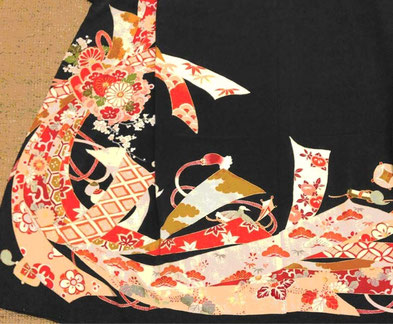
This tomesode has a particularly full yuzen hakkake of almost the same design as the exterior, though the interior lacks the
delicate gold-wrapped threadwork. Here's a closer pic of the noshi design, which remains clean and bright with no damage. Even the black ground has remained relatively strong, a rarity, as the
black of kuro-tomesode tomesode is infamous for fading with age. The range of reds, pinks, salmon and oranges were typical and very popular natural dyes of the period, though analine dyes were
widely used from the mid-1850's onwards. Bought in Osaka, Japan.
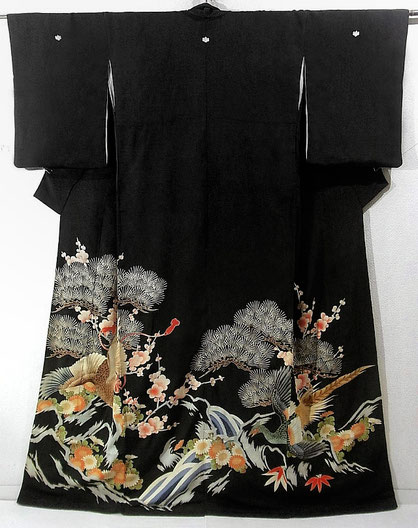
Susohiki tomesode with yuzen and surihaku, plus yuzen hakkake. Length: 69.5"
Something more unusual in the form of a beautiful mid-Showa kurotomesode cut specifically for dance. This type of kimono is
called susohiki, meaning 'trail the skirt', as it is made with extra length to be worn with the skirt trailing along the floor behind the wearer. Susohiki and hikizuri are interchangeable
descriptions of the same type of kimono, each meaning the same thing--to 'trail the skirt' in different regional dialects.
Susohiki can be found in several categories of kimono according to their formality, so you may have furisode, kuro-tomesode, iro-tomesode, homongi or komon (the last seen only in geisha, odori or stage communities). In this case, with its design limited to the hemline on a black five-mon kimono, this is a formal kuro-tomesode susohiki.
This is actually one of my favorite designs, since not only is it stunning and dynamic, but it also tells a small story within the image. The design is that of a hunting hawk (we know that it's a hunting hawk because it has a silk tasseled cord tied about one of its legs, so it's not a wild bird), having just seen a golden pheasant going to ground (we know it's going to ground because it's lower in the design than the hawk, so that when worn the hawk is suspended mid-air against black, whilst the pheasant is at floor-level). Hawks hunting pheasant is an old Japanese euphemism for men courting ladies, so what we're seeing here is a quite flirtatious design for a rather confident mature woman, adept at the subtleties of getting her message across before even a single word has been spoken.

Close up, the detail on the hawk is breathtaking, and even smaller
elements in the design such has the sakura (cherry-blossom) are beautifully rendered.
Often on these pieces the main elements such as the birds would have been done by a time-served and very experienced craftsman, whilst his apprentice would have been charged with other details, such as flowers and water, learning not just the colourwash techniques on less visible parts of the design, but gaining the confidence to work smoothly in this freehand medium which gives the artist one chance to get it right. By the painting stage, the kimono would have gone through many individual processes encompassing many hours of work, making even an unfinished piece of this standard worth thousands, so the artisans need to be well-versed in their craft.
The interior of this kimono has a matching yuzen hakkake design of pine and cherry blossom, and an ivory silk doura( (upper lining). The doura in this case is scuffed with red about the points where it would come into close and continuous contact with a silk juban (under-kimono). A widely-acknowledged rule of kitsuke is that tomesode are worn with white juban, and the kimono's probable mid-Showa date, means that colourful juban were no longer in fashion anyway, meaning that this piece might have been owned by a geisha or geiko, generally the only women who still wear dance susohiki with bright a red juban.
Sourced in Osaka, Japan.

Taisho-era Noh tomesode with yuzen, surihaku and hiyoku. Length: 67.5"
Another Taisho-era tomesode, though this one is a little earlier, as evidenced by the longer sleeve length and the deep red
lining. This is a very beautiful high-end five-mon tomesode in the softest kinsha silk, and my absolute favourite of
the tomesode that I own. It has a beautiful full yuzen hiyoku (inner layer designed to look like a second kimono) which has a design in harmony with but not copying the outer noh mask and bamboo
design. The slight fukiwata (padding to hem) combined with the long length (considering that it's pre-WWII) and the height of the inner hiyoku towards the waistline, all make it probable that
this was made to be a hikizuri (kimono designed to be worn trailing, as shown on the mannequin below).

Here are a couple of pictures of the main design on the front panels. The far image is the outer kimono with a beautifully rendered noh mask, and the near image is
the inner hiyoku, with a similar but less effusive bamboo design. Each of these layers also has its own full yuzen
lining.
The quality of this piece combined with the choice of design (noh theatre), as well as subtle differences to the cut of the collar and the set of the sleeves and, most importantly, the kamon design leads me to think that this piece may have been a Geisha's kimono.

Each Geisha house in each district has its own unique kamon design, and through them a piece can sometimes be linked to an individual Geisha okiya (though this isn't always reliable; as they mature and gain independence geisha will cease to be reliant on their okiya for their kimono, and any that they commission for themselves will be likely to carry a different kamon, even if they remain linked to their okiya).
Here's a pic from the back, showing what a hikizuri looks like trailing, and how the design works with that. In this case the dummy is set probably a good deal taller than the original wearer, as it's set to a contemporary 5'7 height, but you can see how the design works with the trailing hemline. Anyone who wears kimono will also be burning to tell me that the entire ensemble is not dressed as a Geisha would wear it, but instead is fitted as anyone might wear it to go to the theatre for a performance.
This kimono has been well worn and has thin staining throughout the main design as well as a general slight fading of the black, but the beauty and subtle harmony
always draws me in.

Antique hikizuri with yuzen and surihaku. Length: 69"
A stunning, fluid cherry-blossom and stream design hikizuri which I know almost nothing about! It's seen here draped over a form, since it came into my hands disassembled, and has been only loosely tacked together as a guide.
The silk has an old feel and is not as tightly woven as post WWII machine-weave, and the colour-wash quality of the hand-resist yuzen work as well as the placing of the delicate surihaku all feel like very early Taisho. The particular style of surihaku is also seen on the easier-to-date early Taisho tan coloured iro-tomesode further down this page. But I have no provenance with this one, and its nature as a performance kimono means that it has been altered and re-lined several times, hiding it's past. The sleeves are also the longer-length of pre-WWII Taisho-era, and the single mon to centre-back is a later, stitched addition on its own black chirimen ground, a method often used in Japanese theatre as well as odori (dance). The quality and delicateness of the yuzen add to the old feel, and you can see that the sleeves are still lined with their original red silk, often indicating a pre-WW II kimono.

Unfortunately the entire rest of the lining has been removed and replaced with recent cotton, as often
happens with odori kimono. I have a vague memory that this was one of two identical kimono being offered for sale at the time and so wonder whether, given its Kyoto provenance, it could have been
used in one of the many annual public dances held around the Cherry-Blossom season. The only thing which makes me unsure is the quality of the yuzen work, which is clearly made to be seen
close-up, although the general flow of the piece would lend itself to both dance and theatre. I have other odori pieces, and even older ones tend to have a very bold design with a fair amount of
gold-work, since they are made to be seen from a distance and often under artificial lights. This could, then, have been made for appreciation by a closer audience, such as ochaya odori, although
in such an instance, I would expect to see the kamon of one of the recognized geisha houses.

This kimono had also been fitted with a non-original pink chirimen hiyoku with a subtle shibori design, and a heavyweight fuki-wata, by the time it came into my hands. But this too may hint at a past version of the same with a lighter fuki-wata (as befits its Taisho origin), as this inner layer wears out quite quickly in trailing hikizuri, where it drags across either wooden boards or tatami.
This piece presently remains disassembled (it came to me that way), until I can gain enough information to restore it sympathetically without confusing another generation of collector! Sourced from Kyoto, Japan.
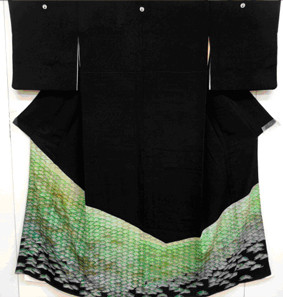
Contemporary tomesode with yuzen and surihaku. Length: 66"
This relatively modern tomesode probably dates to the 70's but has had almost no wear. The reason seems to be that the original
purchaser paid to have it made up with a very pale green hiyoku (inner layer designed to look like a separate kimono) of incredibly heavy chirimen silk and comprising a far higher susoyoke (skirt
section) than normal, the combination of which made the kimono almost unwearable in its weight. Any susohiki or uchikake would of course weigh far more, but in this case the kimono was clearly
not made to be worn trailing, yet the weight of the skirt made it impossible to maintain an ohasori (a traditional fold to the waist) without trussing the entire ensemble uncomfortably tightly.
So it was probably consigned to a drawer and left well alone!

When I received it and put it on for the first time, it took me a while to work out what was wrong and why my ohasori was always awry, but when I did I removed the heavy chirimen hiyoku completely, and the problem was instantly solved.
The simplicity of this stylized design, as well as the very solid edge, link it closely to the mid seventies - mid eighties, and
although it looks severe when opened up, when worn with a green and gold obi, the design is pleasing in its understated confidence.
Don't forget you can navigate between pages by clicking on the small blue three-bar icon at the very top left of this page - other pages and subjects will appear.

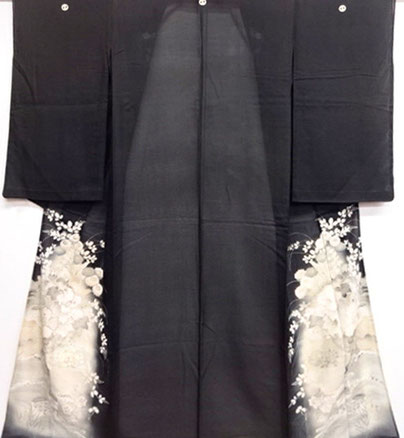
Antique ro silk tomesode with yuzen and kinkoma. Length: 60.5"
I'm not too sure when my love affair with ro began, but I do know that I have a disproportionate amount of it in my kimono
closet--particularly given its very short season! This is another early Taisho tomesode sporting the classic mirror positioning of the design which pre-dated the slow change to maemigoro
(left-front to right sleeve bias). Ro is for the height of the humid Japanese summer in July and August, its open weave and general lack of lining offering a little respite from the heat and
humidity. So although there's no red lining to lock this one down time-wise, the longer early Taisho sleeves and mirror
design are something of a giveaway.

This is a beautifully soft ro, with a subdued colour palette for the yuzen work to the front which locks it closer to the noh-design
tomesode than to the brighter noshi-design piece. Seen closely, it also has just a small amount of pale gold threadwork to lift it, as well a tiny amounts of hira-nui embroidery. A piece like
this would usually be worn with a white ro nagajuban underneath, and a ro cotton or linen hadagi against the skin, so although the idea of a
semi-transparent kimono seems quite risqué, it was in fact the very epitome of the demure and stately wife. Bought in Osaka, Japan
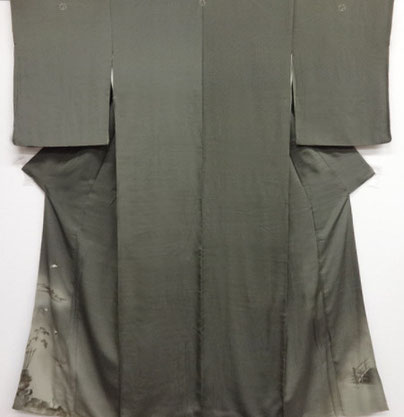
Antique grey kinsha iro-tomesode with hand painting, shishu and hiyoku. Length: 60.5"
A Taisho iro-tomesode with delicate hand painting and hand embroidery to the hemline. This one is a difficult one to pin down,
time-wise. The ply of the figured kinsha is exceptionally soft and fine with a delicate touch, though the hand painted design has clearly begun to move from a mirror image to a slight left-front
bias. Sleeves are only an indicator if they are still long, as it's easy to shorten long sleeves of an old kimono at any time to bring it up to date, whereas adding length to a more recent kimono
to simulate age would be be an impressive trick!

This is a three mon tomesode, and the mon are embroidered, which ranks them slightly lower in the formality scale, but these too could have been added at a later date to formalize a more casual kimono--though the semi-gloss finish of the kinsha again lifts it in the formality stakes. This is the only tomesode I own which has a full-body hiyoku, meaning that in this case the subdued tea-green silk is visible not just at the skirt and collar, but also lines the sleeves in their entirety.

Hand painting is as popular today on high-end kimono as it ever was, though this particular style is redolent of Meiji era tomesode in technique, spacing and placement--a reliably dated example of which I'll post here, for comparison. But a useful consideration in this instance is the subdued colour and low placement of the design, which would indicate an older lady, so this kimono may simply have been made in the early to mid Taisho period to an older Meiji style which she personally remembered and preferred. So this could be any period from late Meiji to mid-Taisho, I think. In the hand it feels old, but not at all Meiji-old, despite its appearance.
A beautiful kimono though, with delicate hand painting , as well as feathered-edge sashi-nui embroidery to pick out detail and give
solidity to the rocks to the edge of the river scene, and hira-nui to create flying cranes. Sourced in
Osaka, Japan.

Taisho-era kuro-tomesode hikizuri with yuzen and surihaku. Length: 69.5"
A mid-Taisho kinsha kuro-tomesode, whose red lining and longer-style sleeves could lock it down to early Taisho, though the clean, bright design and the feel of the silk in the hand make it more likely mid to late Taisho. This is another hikizuri--a kimono designed to have its hemline trailing when the wearer walked, which accounts for its long length. As for
type, a design limited to the hemline on a black five-mon kimono drops it into the formal tomesode-hikizuri class.
By this time hikizuri were traditionally seen in only three spheres; dance, wedding and geisha. The short sleeves and lack of any
traditional wedding and celebratory themes in the design can rule this out as a wedding hikizuri, leaving only geisha and odori (dance). This is a five-mon kimono, and though the kamon design isn't familiar to me (as one of the many dance-schools), I confess I haven't looked that hard to try to track it down yet.

Odori kimono of this age tend to have lost their original red lining by this point, as they've been used many times for different performances, and the original silk lining tends to degrade and be replaced by a more robust cotton one. Despite this one retaining its original lining, it's still infinitely more likely that this is an odori kimono than a geisha one.
For its age this hikizuri is in great condition, with the gold surihaku kanji to the main panel showing minimal wear, and just a few very thin stains visible within the pale sections of the ougi fan designs. It has a little fading to the black, which is typical, but its yuzen colours are bright and vibrant, both to the outer fabric and the yuzen-decorated hakkake. Sourced in Kyoto, Japan.
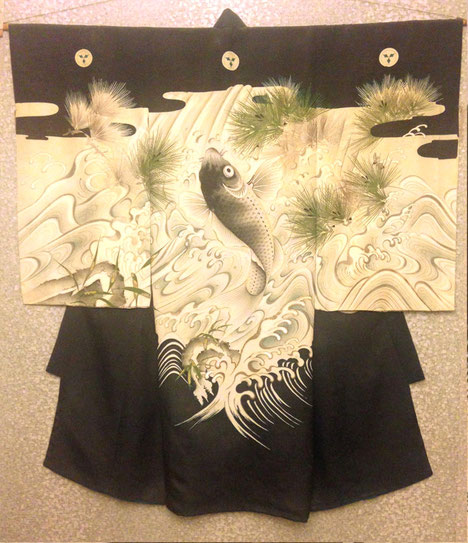
Taisho-era boy's tomesode with yuzen and shishu. Length: 37"
A Taisho boy's tomesode, this one probably on the cusp of Meiji and Taisho, as evidenced by the larger Meiji-sized kamon to the
centre back, either side of the chest, and sleeves. The early Taisho era saw the size of kamon reduce considerably, giving a good, though not difinitive, indication of
age.
There are a lot of carp-design boy's kimono around, often very similar to this classic style, but modern versions are easy to distinguish in terms of the quality of the hand painting and the feel and drape of the modern silk, both in the outer shell and the lining. Carp were a popular theme for boy's kimono due to the belief that koi exemplified the desirable virtues of vigor, perseverance, and purpose--suitable aspirations for one's son

Legend also told that the koi carp who struggled up a certain stream to pass under a particular torii would be transformed into a dragon--another inspirational
lesson for a hard-working son. This kimono has yellowed a little with age, and seems to have had the black area professionally re-dyed at some point--perhaps for a second generation to wear,
though that would be a rarity in Japan, where new stages of life demanded new attire. But the quality of the hand-painted koi and waves, and the delicate silver and white hara-nui embroidery
which brings the water alive to practically glisten, make it a stand-out example of its kind, leaving me to wonder what became of the little boy who wore it probably with great pride during his
sichi-go-san ceremony. Sourced in Kyoto, Japan.
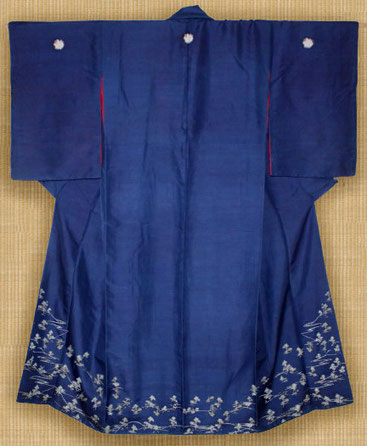
Meiji-era iro-tomesode with yuzen. Length: 58"
This Meiji-era iro-tomesode is indigo-dyed, one of the oldest dying methods known, which came to Japan through China's Silk Road. The technique is identified as 'ai' in 1st century Chinese documents, and items listed as being dyed by 'ai-zome' are found in Japan by the 7th century. The Edo period's sumptuary laws brought ai-zome to the fore when edicts restricting the wearing of silk made cotton a popular choice for the wealthy merchant class, of which there were few dying methods at the time. Even today the link between ai-zome and cotton remains, in the popularity of blue yukata.
You can see the remnants of those same sumptuary laws applied to silk too, where they restricted not only colours, but the amount of decoration that could be applied to kimono, as well as its positioning, depending on the social class of the wearer. Here, as is typical, the design is suso-moyo--limited to the hem--and the colour is plain, subdued indigo.
It might be easy to imagine that like many others, this kimono started out its life as a furisode with embellishment to the lower part of its long sleeves, and was subsequently converted to an iro-tomesode when the wearer married. However, looking at this particular kimono I wonder whether the very broken, subdued nature of the design meant that it was always intended to be an iro-tomesode for a married woman (compare the amount and exuberance of the design to the red Meiji furisode of roughly the same period, on the furisode page).

This tomesode has a red silk lining with a yuzen-decorated hakkake which is typically shorter than modern ones, as was the style for the period. It is lightly padded throughout, with a very slight fuki-wata and no horizontal waist seam, again a defining feature of the time, locking its date a little tighter.
Indigo generally retains its colour very well, and the plain, hand-woven silk has no flaws and clean hold-out to the yuzen work, with no bleed-through of the bright red lining. Even the tiny egg-yolk yellow buds on the pine--the only colour applied--are clear and bright. Sourced in Kyoto, Japan.

Meiji-era kuro-tomesode with yuzen, hand painting and kinkoma. Length: 59.5"
Another tomesode from my favorite era! Probably a fraction later than its lilac cousin on the
furisode page, it dates somewhere between 1880 and 1910, and being black is the most formal of tomesode, with five mon. Again, like the blue
tomesode above, I think this one was always designed to be a tomesode, rather than having had its sleeves shortened.
The hand-painted suso-moyo design is within a yuzen holdout area, with the distant hills and a few trees being used to both define and break the yuzen line.
The design of pine trees and cranes in a continuous but not mirrored landscape means that it could
easily be interpreted as a wedding kimono whose sleeves have later been shortened, but look closely on the second set of smaller pictures below, and you can see a yellow dash painted beneath each
of the flying crane's legs. Since this isn't a misregistered katazomi (stencil), and no two are the same; each was purposely applied. These are actually tanzaku, a type of prayer slip generally
decorated with gold, silver or mica, on which a person wrote their prayers and wishes.

Today, they are associated largely with the Tanabata festival in July, when they are tied to trees and
specially-placed bars within temples, but in the past they were also used on New Year's day, when one visited the temples to wish for an auspicious year ahead. Monks would tie the hand-written
tanzaku to the legs of cranes, who supposedly then carried them off to be read by the gods. Cranes, along with pine and bamboo, are also symbols of longevity associated with the New Year, the
crane believed to live for 1000 years. You can see the tanzaku clearly in this Hiroshige woodblock linked to the New Year (Hikaku (flying crane) by Hiroshige, RISD Japanese New Year
exhibition, Germany).

If you look closely at the second image of the flying crane on the tomesode, you can see the small
golden tanzaku which have been tied to hang beneath their legs in the same way as the Hiroshige image above. The first image to the left is of the main panel, in which two crane stand beneath a
pine tree. New clothes were often made to see in the New Year, and given this one's reference to tanzaku, this is probably a tomesode made for the occasion--the only one I've seen which
references both tanzaku and Hiroshige's woodblock of cranes carrying them (if the kimono had been made for the July Tanabata festival it would have been hitoe;
unlined).
The kimono is in very good condition, although the white has begun to grey very slightly. But the strong black ground is both rare and worrying. Rare because kimono seldom retain this depth of colour, and worrying because the only way to ensure it, would have been to use mineral salts as a mordant, to set the black dye. Very common in the past, and the bane of every antique and vintage silk collector, mineral salts were used on both high-end and mainstream silk, to reliably fix the dyes and to add weight and lustre to silk at a time when weavers sold silk by weight, not length. In fact mineral salt could account for more that fifty percent of the weight of even high-end silk.
However, long-term, the mineral salts degrade the silk, accelerated by residual humidity in the air. Annual changes of temperature and their accompanying humidity swings saturate (and so swell), or de-saturate the silk, and the combined destructive power of the UV end of the light spectrum on the protein in silk, and the mechanical shredding action of sharp mineral salts, will cause silk to 'shatter'--an irreparable failing of individual flosses within the thread which will shred and disintegrate the fabric. This particular kimono has a very specific density and stiffness to the outer shell which hints at heavy mordants. It's presently in excellent condition, so I may be wrong about the mineral salt content--but I don't think so. Unfortunately there's nothing can be done, save to store the kimono carefully in tightly controlled conditions to extend its life, and enjoy it whilst it lasts--the very definition of Japanese ephemeral beauty. Sourced in Tondabayashi City, Osaka, Japan.
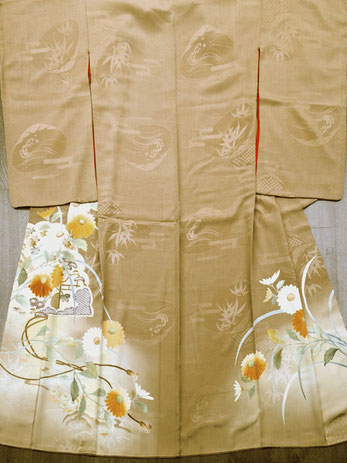
Early Taisho rinzu iro-tomesode with yuzen. Length: 59"
This is a Pre-WWII iro-tomesode--probably 1930's-- with a very large and well-defined rinzu design of
seashells and mist, and you can see that the analine dyes were still in the minority here, being used only to mimic plant dyes, if they were used at all. The images on the rinzu seashells
(referencing a shell-matching game) are of bamboo against mountains, and rough sea waves, referencing a very old Japanese game using engraved or painted seashells.
The main yuzen panel is of a single ougi and chrysanthemum, and you can see the overall design, previously a mirror-image to both sides of the kimono's front, beginning its slow movement to the main left panel, as it continues to do throughout the Taisho era. There's a very small amount of surihaku here and there--as can be seen on the close-up image of the leaf below--as well as hara-nui to the edge of the petals, and a little sagara-nui to the centre of some of the chrysanthemums.

This kimono has just one mon to the center-back, which ranks it as the lowest of the mon tomesode, and
also accounts for the quite muted design. It retains its full red lining, and a hakkake of the same base colour as the outside, this time in plain
silk. Sourced in Kyoto, Japan.

Taisho Geisha susohiki kuro-tomesode with yuzen. Length: 70"
Another pre-WWII tomesode, this one a kinsha
susohiki worn by a geisha (a Tokyo okiya, I think, based on the kamon). The design is of lacquered sake cups and gourds floating in rushing water overhung by cherry blossom,
rendered with yuzen technique. This tomesode has a hiyoku (an inner layer designed to look like a second kimono) of the same design as the outer one, but set against a pink background rather than
a black one.
It's interesting that this susohiki and the iro-tomesode above were probably made within a decade or so of each other, but whilst the one above is meant for a demure wife, this one, with its effusive and eye-catching design, was intended for a geisha.
Still, we can see the same shared techniques that were in vogue at the time, such as the spray-bokashi background, the developing maemigoro (left-front design bias) and the chrysanthemums rendered in a partial sweep of colour that left half the petals white.

Despite its vibrancy compared to a wife's tomesode, as with many geisha kimono it actually has quite a limited colour palette--bright confectionaries are for maiko; geisha tone down even their most extravagant ensemble for that iki touch.
For a geisha's kimono it's also in good condition, with just a few smudges and very thin stains, and a little age-related patina. It also has one tiny hole to the back of one cuff, which looks like a cigarette came a little too close! A few loose stitches can always be re-sewn, with the only really noticeable flaw being white marking to the collar, due to having been worn as a formal tomesode. Sourced in Osaka, Japan.

Antique Karako Design Iro Tomesode
Length: 63.5"
In many ways this is an unremarkable tomesode. Pre-WWII, it is a dark madder-red rinzu
(damask) silk, with a red hiraginu lining. What sets it apart for me, is the design. This is an effusive rush of karako (children in traditional Chinese clothing) playing, running and dancing their way across the entirety of all six panels to the
hemline of the kimono.
Children, both Chinese and Japanese, are a popular theme on women's kimono, linked with the obvious desire for the wearer to bear many of their own, but often for nothing more than the joy of seeing them. But this is the only kimono in which I've seen so many on a single kimono!
The dynamic design has each child dressed in a different outfit, enabling the artist to show off a number of painting skills, from brush bokashi to surihaku to freehand yuzen-moyo.

The faces in particular are sweetly and delicately rendered, with lightly-blushed cheeks, rosebud lips
and softly-tufted hair. The gold glaze is still clear, with the designs on the clothing bright and strong.
This is a single-crest kimono, and so quite far down in the formality stakes. In fact it's rendered a little lower by the fact that the crest is sewn--the most
informal way to render a family kamon. When you look carefully, the design is also only required to be matched across the first two and the final seams, rather than every panel, further lowering
its formality stakes.
The condition of the kimono is relatively poor, with repairs to a few points in the children's hair, where the heavily-mordanted black dye has made the silk weak. There are further weak areas to
a few more heads, which will need support in the future. In and of itself, the kimono has no special value--but the vibrant and playful design makes it worthy of a place in any
collection.
Sourced in Yokohama, Japan.

Pair of Meiji 'ai' Iro-tomesode with right-hand (hidden) design.
Length: 57.5"
Another
ai (indigo-dyed) kimono from the Meiji era. This pair are a little earlier than the indigo tomesode a few above, as is reflected in their design.
These two kimono were bought at the same time, and are the same measurements exactly, as well as holding the same mon. I wasn't surprised when the dealer informed me that they came from the same owner. There's something quite nice to that--that over all this time, they've stayed together...and if I can help it, will do so for many years to come.
This first one is lightly padded silk chirimen, with a small design limited only to the lower part of the front right panel, which would effectively be hidden for the majority of the time when worn--the height of iki!
It could be that this was the entire reason for the hidden design, but it's more likely that this tomesode adheres to the sumptuary laws prohibiting the display of yuzen-work on women’s kimono to certain classes. In this case, to hide and yet still have the yuzen work, it has been placed on the right hand side of the kimono hem, meaning that it would be folded beneath the left hand side and so not immediately visible from the outside with only the slightest hint of the fade-line of bokashi letting others know that it was there, in true iki style. Perhaps a glimpse of the design might be seen whilst walking, but otherwise it would adhere to the strict laws banning decorative kimono laid down by the Shogunate.
The silk is hand spun and woven, with the outer fabric being ‘ai’: indigo-dyed, which was thought to have beneficial health benefits for the wearer, and was also one of the few unrestricted colours which could be worn by any social class throughout the varying sumptuary law periods. The inner lining is beni (saffron) red, with a slightly differing hand-painted yuzen design on the inner right hakkake.

Here's
the second of the two kimono, again another indigo tomesode, this time on a far smoother hiraganu-base silk. But again the design is restricted to the hidden inner-right panel and its matching
hakkake panel, and the style of execution is very similar--probably by the same artist. In both cases the decoration is an incredibly delicate freehand painted design
(yuzen-moyo technique) set within
a bokashi (gradient-dye) area.
Both designs feature small amounts of silver-wrapped kinkoma used to lift the image,
suggesting dew on the painted leaves, with a single flower head picked out by the slightest application of red or yellow. It's
interesting to note that the kinkoma detailing which lifts the very subtle pattern is applied only to the hakkake (lining) side of the kimono--something only the wearer would
see.

Both kimono have survived very well, with slight fading to the indigo dye. The hiraginu silk kimono has a little bruising to the thinner silk along with some puckering to the seams, suggesting that the silk thread used to sew it may have shrunk slightly in a differing ratio to the main woven body of silk--something that is easily remedied by disassembling and re-sewing the kimono with new silk thread.
Unlike its partner, this second kimono has no padding, but a slightly denser fukiwata, typical of the period.

'Hiraginu' refers plain silk with a very smooth, plain texture and touch (hira means 'flat' and ginu(kinu) means 'silk'). The most typical hiraginu is the habutae, which is often used for men's formal kimono and haori. This textile is woven with the most basic plain-weave technique, its yarn not twisted in the weaving process. Under a microscope the surface is a neat grid pattern, with both weft and warp yarns equally visible.
Here you can see both of the kimono designs close-up, their hand-painted nature obvious, and their style very similar to both the blue and the lilac antique Meiji chirimen furisodes which share the same time period.
To have both of these kimono together feels quite special, and I hope that they remain so for a long time to come!
Sourced in Nigata, Japan.
Don't forget you can navigate between pages by clicking on the small blue three-bar icon at the very top left of this page - other pages and subjects will appear.

